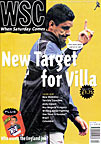 They may be rushing the exits at Loftus Road thse days but, as Anthony Hobbs explains, at least they're doing it in comfort thanks to an enigmatic stroller
They may be rushing the exits at Loftus Road thse days but, as Anthony Hobbs explains, at least they're doing it in comfort thanks to an enigmatic stroller
Littered around the country are grounds and bits of grounds bearing the name of a local hero. Preston have even put a picture of theirs on the seats in case you forget who he is. What fine tributes these are to the skills of past masters, lovingly constructed to ensure that the memory of a great player lives on long after he has gone.
In 1992 though, QPR embarked on one of the most ambitious pieces of player-recognition capital work undertaken anywhere in the Shepherds Bush and Acton area. Not only did it pay fitting tribute to one of Rangers’ great players, it formed the cornerstone to an impressive stadium redevelopment that included almost 50 new seats, new sinks in the toilets and the replacement of some arrows indicating ground facilities.
It could also be said to have started the final deterioration of supporter/chairman relations that would eventually lead to relegation for the team and exit for the owners. The sale of Rangers’ most naturally gifted player, Roy Wegerle, during the summer of 1992 caused much debate amongst supporters. Wegerle was a player seemingly genetically engineered to have his name linked to the words mercurial, enigmatic and languid. Accordingly, while some bemoaned that Rangers’ trait of selling star players precluded us winning any trophies, others rightly pointed out that while your star player is Roy Wegerle, you’re not likely to win anything anyway.
In a pivotal moment of corporate ignorance, Rangers and their erstwhile chairman Richard Thompson (the property developer, not the folk singer) managed to misjudge the mood of the supporters by a country mile. Most pragmatic fans are able to accept that maintaining a Premiership existence on the back of 13,000 gates requires a degree of fiscal rectitude which can have the odd unpleasant side effect. The best response as a supporter is to cup one’s hands over one’s ears and refuse to listen, hoping that all the bad things will just go away. This approach is something Rangers followers became well used to during the ten years of the plastic pitch, when the unspoken rule was never, ever to admit publicly that it was a dreadful surface.
The club’s mistake was in almost cheerfully announcing that the proceeds from the Wegerle sale would be used to put new staircases on the back of the South Africa Road stand (neatly linking Roy with the country of his birth). This is something we could probably have done without hearing, thanks all the same. Worse still, the club maintained that we would be delighted with the results since “they will make Loftus Road look like the San Siro stadium”, a comment made with rather less irony than many would have liked.
By the start of the 1992-93 season, the Roy Wegerle Staircases were complete. Unfortunately, the approach to the ground did not really evoke images of the San Siro brought to Shepherds Bush. The twin vertical blue metal tubes stuck to either side of the 1960s concrete club office building did little more than confirm to anyone interested exactly how much corrugated steel it is possible to buy with £1.2 million.
They did, however, offer an unparalleled speedy exit from the ground – something that would be tested rigorously during matches over the next few years. They also provided a talking point in the stands. Some thought the staircases were about as mobile as the indolent Wegerle. Others pointed out that, following our chairman’s logic, we should expect to see around five more of our squad sold, since the dressing rooms could do with a lick of paint.
As the tannoy announces that, “Supporters should leave by the Roy Weg… the er, staircases to either end of the South Africa Road stand” we are reminded that to this day the club refuses to recognise Wegerle properly by officially naming the staircases in his honour. But everyone who sets foot on the beautifully crafted yet surprisingly functional steps knows where the credit for their construction lies.
If the club won’t recognise Wegerle’s input, then WSC certainly should by nailing up the following plaque: “Roy Wegerle Staircases: On this site in 1992, Richard Thompson’s last remaining marble slipped from his grasp.”
From WSC 146 April 1999. What was happening this month